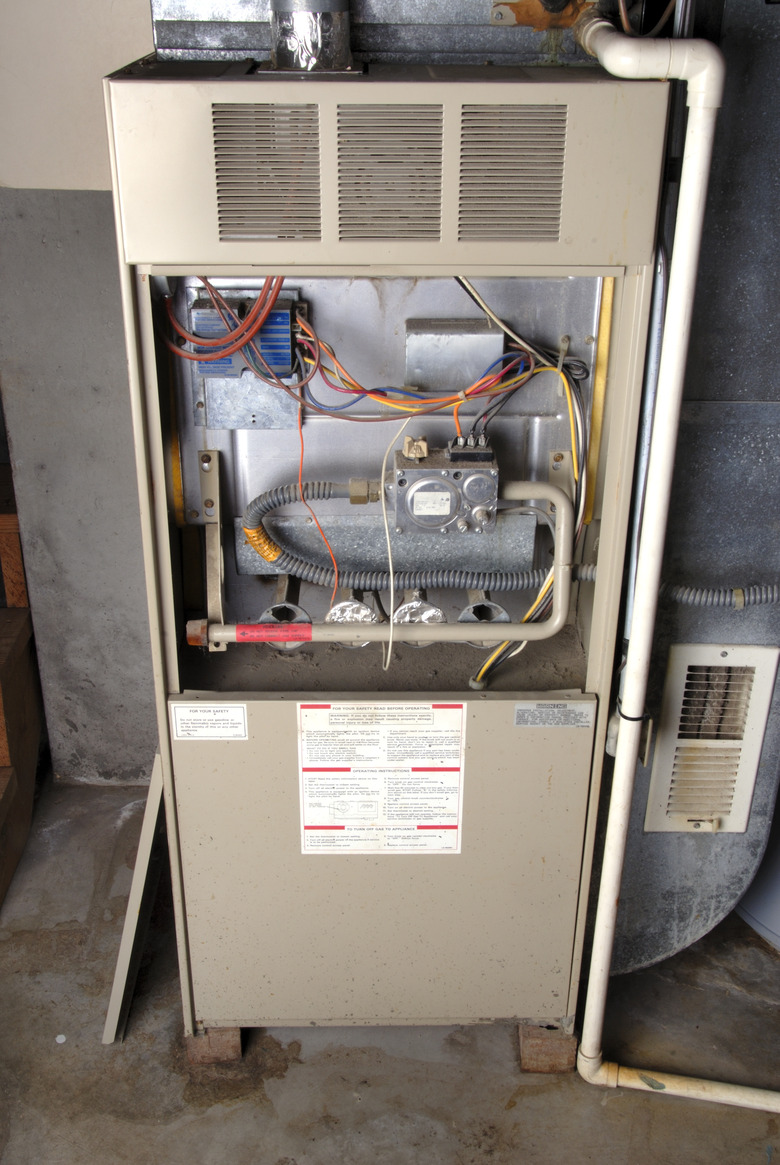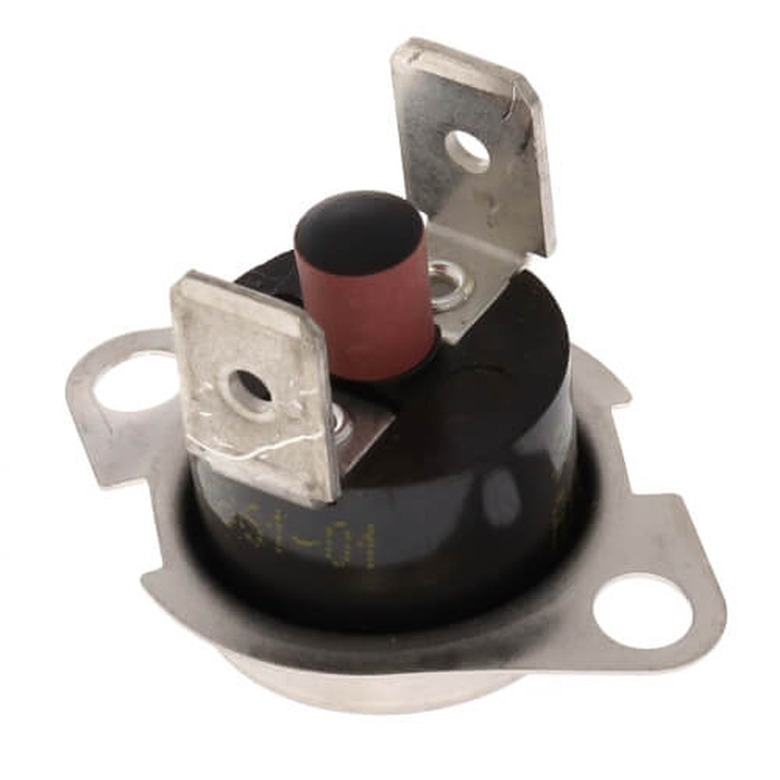Malfunctioning Furnace? It Could Be Your Furnace Limit Switch
We may receive a commission on purchases made from links.
Burning gas in a furnace always introduces the potential for overheating, so to prevent a catastrophe, every furnace has a high limit switch that shuts off the gas if the temperature inside the plenum, which is just above the heat exchanger, exceeds a preset value. In addition, most furnaces also have a fan limit switch, and its purpose is to prevent the blower from blowing cold air into the house. The fan limit switch is normally open and closes when the temperature reaches its preset value, whereas the high limit switch is normally closed and opens when the temperature reaches its threshold value.
These switches are separate on some furnaces, but most furnaces feature a combination switch that performs both functions. It's attached to the side of the burner housing just above the heat exchanger and is easily accessed by removing the furnace cover. If your furnace is malfunctioning, the problem could very well be a faulty limit switch, but since it's a safety device, it may be operating normally, and the culprit could be something else. Testing a limit switch is a DIY task that requires only a screwdriver and a multimeter, and if the switch is faulty, it's easy to replace.
What Does a Limit Switch Look Like?
What Does a Limit Switch Look Like?
Limit switches come in two varieties. Older electro-mechanical switches consist of a probe about 6 inches long that extends into the plenum (or a box attached to the ductwork that distributes the air) just below the point where the ductwork is attached. The probe on more contemporary solid-state switches is disk-shaped and extends into the plenum only an inch or so. Both types of switches are mounted on plates that screw onto the burner housing, which is the flat metal plate you see in front of you when you remove the furnace cover. Electro-mechanical ones have a dial that allows you to adjust the temperature at which the fan limit switch starts the blower and the temperature at which the high limit switch shuts off the gas. You won't see this adjustment dial on a solid-state switch. This type is preset and possibly a reset button. Replacement will need to match the preset value.
The plate on a limit switch usually has two or four wire terminals. A fan limit switch needs a pair of 120-volt terminals to connect the furnace blower and the control panel, while a high limit switch has a pair of 24-volt terminals for the gas valve.
Troubleshooting Limit Switch Problems
Troubleshooting Limit Switch Problems
Because a combination furnace limit switch that includes both a high limit switch and a fan limit switch has two jobs — to signal the blower to switch on and off based on the temperature in the plenum and to shut off the gas if the temperature gets too hot — it can cause the furnace to blow cold air in two different ways. If it fails in its first function, it doesn't signal the blower motor to start and/or stop properly. If it fails in its second function, it shuts off the gas when there is no danger of overheating, and the furnace stops producing heat. If the high limit switch trips repeatedly, the furnace goes into hard lockdown mode and won't come on until it is professionally serviced.
On the other hand, the high limit switch may be operating normally and shutting off the gas because the furnace is actually overheating. This is usually due to poor airflow caused by extremely dirty filters or a mechanical problem with the blower motor. Before assuming the limit switch is at fault, you should clean or replace the return air filter as well as the outflow filters. If the filters are dirty, the blower may also be dirty, and this can cause it to malfunction.
Tip
To check the operation of the blower motor, switch the setting on the thermostat from Auto to Fan On and make sure the blower comes on and operates normally without making strange noises.
In the absence of problems with the blower motor or the filters, you should test the limit switch, and you can do this with a multimeter in one of two ways. You can measure voltage across the switch terminals, or you can test for continuity, which calls for measuring resistance between them. Because the furnace has to be on for a voltage test, a continuity test is safer and will usually tell you all you need to know.
Testing a Limit Switch for Continuity
Testing a Limit Switch for Continuity
When you test a switch for continuity, you use a multimeter set to measure resistance in ohms (Ω), which sends a small electric current between the switch terminals and measures the resistance between them. The switch has to be disconnected from power for this test to be conclusive, and you do this by pulling the wire connectors off the terminals. You can conduct the test with the power to the furnace turned on, but since you have to reach in and pull off the switch connectors, it's best to turn the power off. There are only two possible test results: zero (or close to zero), which means that the switch is closed and current is flowing, and very high or infinite, which means the switch is open. Digital multimeters record infinite resistance by displaying OL, which stands for "open line."
Before conducting any tests, set the meter to its most sensitive resistance scale and check it by touching the meter probes together and verifying you get a zero reading. To test a switch, turn off the power to the furnace, remove the wire connectors from the switch and touch each meter probe to one of the exposed terminals. You don't have to remove the switch from its mount in the furnace.
If you're testing a combination switch with four terminals, the fan terminals are on one side and are clearly marked, while the high limit terminals are on the other side and are also marked. The fan limit switch should be open when the furnace is off and full of cool air, so you should get an OL reading; if not, there's a short, and the switch should be replaced. The high limit switch should be closed when the furnace is cold, so you should get a zero reading; if you get the opposite, replace the switch.
To continue testing the fan switch, replace the wires and turn on the furnace. Wait for it to warm up and for the blower to start circulating warm air. Turn off the furnace and if the blower doesn't go off after about five minutes, the switch is still closed. Verify this by conducting another continuity test, which would give you a reading of zero. Then, replace the switch.
When in Doubt, Replace
When in Doubt, Replace
Some tests are impractical even though they give you useful information. For example, conducting a continuity test on the high limit switch when the furnace suddenly cuts out could reveal that it's opening at a lower temperature than it should. The switch is inexpensive, however, costing as little as $4 for some models, so it's safer and easier to replace it than it is trying to work inside a hot furnace. If the furnace continues to overheat and shut down after you've installed the new switch, you can narrow the cause to the filters or the blower fan.
When replacing a furnace limit switch, always use a replacement part that is identical to the original. The cut-in and cut-out temperatures are displayed on each switch, and the temperatures displayed on the new switch must be exactly the same. For example, if the label reads L210, it is a limit that cuts off at 210 degrees. If you use a switch with different cut-in and cut-out temperatures, the furnace won't work properly and may even be damaged. Worse, if the furnace overheats, the burner housing could crack, releasing dangerous fumes into the furnace room, including deadly carbon monoxide.
References
- Conditioned Air Solutions: Get to Know Your HVAC: The High Limit Switch
- YouTube: AMRE Supply – Furnace Limit Switch | Repair and Replace
- InspectAPedia: Inspect & Test Combination Fan & Limit Switches on Warm Air Furnace Heating Systems – Honeywell L4064B
- HVAC How To: Test and Replace the Fan Limit Switch on a Furnace
- Pick HVAC: What is Furnace Limit Switch (Common Problems & Replacement Cost)

